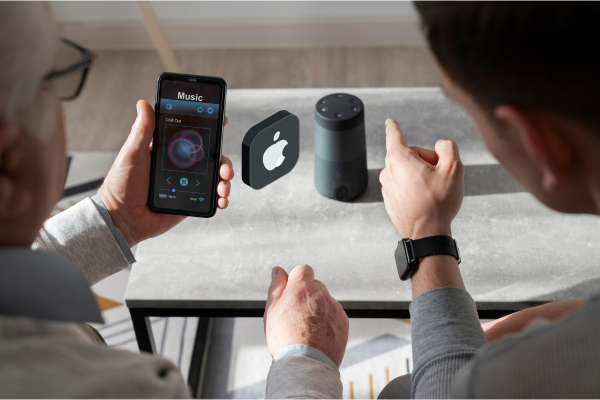Devices with artificial intelligence (AI) are becoming an essential component of our contemporary environment, completely changing the way we engage with technology. They include a wide range of tools and setups aimed at mimicking sensitive behavior. From smartphones to sophisticated health care systems and home appliances, artificial intelligence (AI) technologies have become a seamless part of our daily lives.
Table of Contents
Introduction
The technological marvels known as artificial intelligence technologies simulate human cognitive processes, including learning, problem-solving, and decision-making. These gadgets process information using data and algorithms, allowing them to carry out tasks that have historically required human intelligence.

AI Powered Devices
Artificial intelligence (AI) gadgets are electronic devices that use machine learning algorithms and natural language processing to perform activities that typically require human intelligence. AI tools are used in many different sectors, including manufacturing, health care, and finance. For example, AI gadgets include:
- Smart Speakers: These gadgets understand and respond to voice commands using natural language processing. Apple HomePod, Google Home and Amazon Echo are some examples.
- Smartphones: Digital assistants like Siri and Google Assistant are powered by artificial intelligence (AI). Camera apps also use AI to identify things in images.
- Self-driving cars: AI is used in self-driving cars to guide and avoid obstacles.
- Manufacturing robots: AI is used in manufacturing robots to automate processes and increase productivity.
- Health care management: AI is used in health care management to better diagnose and treat patients by analysing patient data.
- Financial investments are made automatically: AI is used to evaluate market trends and make investment selections in financial investments automatically.
Artificial intelligence tools in everyday life
AI gadgets are widely used. Think smart home assistants like Google Assistant, Apple’s Siri, or Amazon’s Alexa. They handle schedules, respond to voice requests and operate smart home gadgets. AI-powered recommendation engines in social networking, e-commerce, and streaming media tailor user experiences according to tastes and usage trends.
Understanding Artificial Intelligence in Devices
Machine learning, a branch of artificial intelligence, powers AI in gadgets. Without explicit programming, machine learning algorithms learn from data input to recognize patterns and make choices. Over time, the functionality of the gadget may improve and evolve due to adaptive learning.
A dive into physical artificial intelligence tools
There are a wide range of physical AI devices, such as industrial robots, wearable health monitors, drones, and smart cameras. These gadgets can monitor various health data, optimize industrial operations and improve security systems among other things.
Impact of AI tools on health care, transportation and more
AI-enabled medical imaging analysis, customized treatment regimens, and predictive analytics for patient care have revolutionized healthcare. AI is the primary power behind self-driving cars, optimizing routes, reducing accident rates and completely changing the way we commute.
How does Artificial Intelligence power our devices?
Deep learning models, neural networks, and sophisticated algorithms power AI gadgets. They provide a seamless and intelligent user experience by processing massive amounts of data to identify trends and make intelligent decisions.
What makes a device intelligent with AI?
Artificial intelligence (AI) enables devices to learn from data, adapt to new information, and increase their performance over time. They use learned patterns and real-time data to inform their decisions, forecasts, and suggestions.
How AI tools are reshaping the future of technology
The future of technology is being shaped by the inclusion of AI in gadgets. It is fueling innovation in areas such as augmented reality, sophisticated robots and quantum computing and holding out the possibility of a more intelligent, connected and efficient world.

Conclusion
Artificial intelligence gadgets have improved productivity, convenience, and security in various fields, fundamentally changing the way humans interact with technology. The possibilities for creative uses and technological breakthroughs of AI are virtually endless as it is further developed.
- You might be interested in reading these posts as well
- How does Alexa use Artificial Intelligence?
- What is the Smartest Artificial Intelligence?
- What is the most used form of Artificial Intelligence?
- When Artificial Intelligence Goes Wrong
FAQs
Yes, Alexa is an artificial intelligence (AI) virtual assistant created by Amazon. It demonstrates the potential of AI in a user-friendly manner by processing voice instructions, completing tasks, and adjusting to user preferences.
Actually, Google Assistant is an artificial intelligence (AI) virtual assistant that responds to voice requests, uses machine learning and natural language processing to communicate with users and perform other activities.
Siri, the virtual assistant created by Apple, is undoubtedly powered by AI. It employs AI algorithms to understand natural language and carry out activities on Apple products, demonstrating the potential of AI in general technology.
Additional examples include self-service checkout kiosks, intelligent heating systems, facial recognition security systems, and linguistic interpreters.
With the help of AI, which examines user behavior, suggestions can be made more specifically, activities can be completed more quickly, and the overall user experience is improved.
If not adequately protected, AI devices—like any other connected technology—can be subject to cyberattacks. The weaknesses of AI systems can be exploited by hackers, which emphasizes the need for strong security protocols and frequent upgrades to avoid any threats.
There are concerns about job displacement as a result of the ability of AI tools to automate certain tasks and jobs. They can speed up processes and increase productivity, but humans are still essential for creativity, decision making, and solving complex problems. This suggests that the work should be modified rather than completely replaced by machines.
Pingback: What is the Smartest Artificial Intelligence?(2023)
Pingback: What is the most used form of Artificial Intelligence?(2023)
Pingback: How does Artificial Intelligence pose an existential risk?